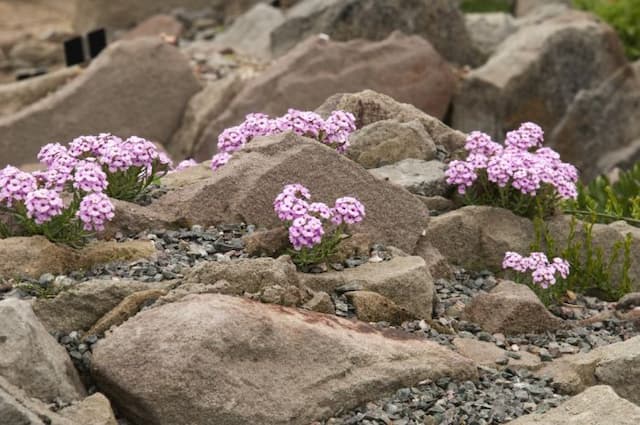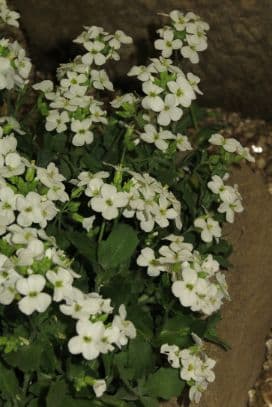Wallflower Erysimum Walberton's Fragrant Sunshine = 'Walfrasun'
![wallflower [Walberton's Fragrant Sunshine]](/_next/image?url=https%3A%2F%2Fplants-admin.emdemapps.com%2Fimages%2Fplants%2F%2Fimages%2F604b53d064aad.png&w=3840&q=75)
ABOUT
Erysimum Walberton's Fragrant Sunshine, commonly known as Walberton’s Fragrant Sunshine wallflower, is a striking perennial known for its vibrant bloom display. This plant boasts a profusion of cheerful, bright yellow flowers that exude a delightful fragrance. The blossoms contrast beautifully with its rich green foliage, composed of narrow, lance-shaped leaves that remain attractive throughout the growing season. The flowers of Walberton’s Fragrant Sunshine are typically arranged in dense clusters, presenting a showy and eye-catching display that can brighten any garden space. Each individual flower has four petals that are arranged in a cross shape, characteristic of the wallflower species and contributing to the plant's ornamental appeal. The bright color and sweet scent of the flowers make them a magnet for pollinators, such as bees and butterflies, which are attracted to the plant for its nectar. Overall, the visual allure of Walberton’s Fragrant Sunshine is found in its lush, continuous blooms and the pleasant harmony of its flower color against the green backdrop of its foliage. This wallflower's ability to provide long-lasting color and fragrance makes it a popular choice among gardeners looking to add a splash of brightness to their landscape.
About this plant
 Names
NamesSynonyms
Wallflower, Walberton’s Fragrant Sunshine.
Common names
Erysimum Walberton's Fragrant Sunshine, 'Walfrasun'.
 Toxicity
ToxicityTo humans
Wallflower is generally not considered toxic to humans. However, as with any plant, some people might experience an allergic reaction or mild stomach upset if any part of the plant is ingested in significant quantities. It is always best to avoid eating ornamental plants due to their potential to cause adverse reactions.
To pets
Wallflower is not commonly listed as a toxic plant to pets such as dogs and cats. Although it is not known to be highly poisonous, it is still advisable to prevent your pets from ingesting this plant. If a pet consumes a large amount of the plant, they might experience mild gastrointestinal upset, vomiting, or diarrhea. If you suspect your pet has ingested a significant portion of the plant, it's best to consult a veterinarian.
 Characteristics
CharacteristicsLife cycle
Perennials
Foliage type
Evergreen
Color of leaves
Green
Flower color
Yellow
Height
2 feet (0.61 meters)
Spread
2 feet (0.61 meters)
Plant type
Shrub
Hardiness zones
7
Native area
Hybrid
Benefits
 General Benefits
General Benefits- Aesthetic Appeal: Adds vibrant yellow color and striking beauty to gardens with its bright, sunny flowers.
- Extended Blooming Period: Offers a long flowering season from early spring to late summer, providing continuous interest.
- Easy Maintenance: Known for being low-maintenance, requiring minimal care once established.
- Attracts Pollinators: Invites beneficial insects such as bees and butterflies, enhancing pollination in the garden.
- Drought Tolerance: Once established, it has good drought resistance, making it suitable for drier climates or water-wise gardens.
- Compact Growth: Its neat, bushy habit makes it an excellent choice for borders, containers, or small spaces.
- Cold Hardy: Capable of withstanding cooler temperatures, it can thrive in a variety of climates.
- Deer Resistance: Less preferred by deer, which can help in gardens troubled by these animals.
- Fragrance: The flowers emit a pleasant scent, adding an olfactory dimension to garden spaces.
- Improved Varieties: Being a cultivar, it's specifically bred for garden performance, including disease resistance and robust growth.
 Medical Properties
Medical PropertiesThis plant is not used for medical purposes.
 Air-purifying Qualities
Air-purifying QualitiesThis plant is not specifically known for air purifying qualities.
 Other Uses
Other Uses- Wallflower 'Walfrasun' can be planted in containers to create a mobile fragrant garden, which is useful for patios and balconies where garden space is limited.
- It can be used as a companion plant in the vegetable garden to attract pollinators, which can help increase the yield of vegetable crops.
- The flowers can be used in cut flower arrangements, offering a unique, sweet fragrance and bright color to any bouquet.
- Wallflower 'Walfrasun' can be used as a natural border in a sensory garden, engaging the sense of smell with its aromatic blooms.
- Due to its compact growth, it is suitable for placement in rock gardens, adding vibrant color to the alpine landscape.
- It can be used in educational gardens to teach about plant lifecycles and the importance of pollinators, as it readily attracts bees and butterflies.
- Wallflower 'Walfrasun' can be integrated into a themed garden design, such as a 'yellow' or 'sunshine' garden, where all plantings feature yellow blooms or foliage.
- They can be used as a natural dye source, as the petals produce a range of yellow to green hues when boiled.
- Planting this Wallflower along driveways and pathways can create a welcoming scent corridor for homeowners and visitors.
- In large public gardens or spaces, they can be utilized in mass plantings to create a dramatic visual impact with their bright yellow blooms.
Interesting Facts
 Feng Shui
Feng ShuiThe plant Wallflower is not used in Feng Shui practice.
 Zodiac Sign Compitability
Zodiac Sign CompitabilityThe plant Wallflower is not used in astrology practice.
 Plant Symbolism
Plant Symbolism- Optimism: The 'Walfrasun' wallflower's bright yellow flowers are often associated with positivity and a sunny outlook on life, reflecting an optimistic attitude.
- Loyalty: Wallflowers have a long flowering season, which can symbolize steadfastness and loyalty in relationships.
- Adversity: Wallflowers are hardy plants that can grow in challenging conditions, symbolizing the ability to endure and overcome difficulties.
- Friendship: The wallflower's inviting fragrance is reminiscent of the warmth and comfort of friendship.
 Water
WaterWater your Wallflower 'Walfrasun' when the top inch of the soil feels dry to the touch, which typically means watering approximately once every week or every other week, depending on climate conditions and season. Utilize a gentle stream of water to soak the soil evenly until moisture seeps out of the bottom of the pot, indicating thorough watering. In terms of volume, during each watering session, aim to provide around one gallon of water if grown in a larger container or garden setting. Cut back on watering during the winter months when the plant is not growing actively.
 Light
LightWallflower 'Walfrasun' thrives best when it is exposed to full sunlight for at least 6 hours a day. Place the plant in a location where it can enjoy the morning sun, which is less intense, and provide some shade during the hottest part of the afternoon if temperatures are very high. They can also tolerate partial shade, but flowering may not be as prolific.
 Temperature
TemperatureWallflower 'Walfrasun' prefers a temperature range between 40 and 75 degrees Fahrenheit. This plant can tolerate low temperatures down to about 20 degrees Fahrenheit, but frost can damage the foliage and flowers. The ideal growth conditions for the wallflower 'Walfrasun' are in the higher range of its preferred temperature spectrum, favoring the cooler end for optimal blooming.
 Pruning
PruningPrune Wallflower 'Walfrasun' to remove spent flowers and to encourage bushy growth and more blooms. The best time for pruning is after the main flush of spring blooms, cutting back the flower stalks by a third to a half. Light pruning may also be carried out throughout the growing season to maintain plant shape and vigor.
 Cleaning
CleaningAs needed
 Soil
SoilFor Wallflower 'Walfrasun', the ideal soil mix is well-draining with a good amount of organic matter, such as a blend of loam, peat, and sand. It prefers a neutral to slightly alkaline pH, between 6.5 and 7.5.
 Repotting
RepottingWallflowers like 'Walfrasun' typically do not require frequent repotting and can thrive if repotted every 2-3 years or when they outgrow their current container.
 Humidity & Misting
Humidity & MistingWallflower 'Walfrasun' tolerates a wide range of humidity levels and does well in average household humidity conditions without requiring any special adjustments.
 Suitable locations
Suitable locationsIndoor
Place in bright light and well-draining soil mix.
Outdoor
Full sun, well-drained soil, and regular deadheading.
Hardiness zone
7-9 USDA
 Life cycle
Life cycleErysimum Walberton's Fragrant Sunshine, commonly known as 'Walfrasun' wallflower, begins its life cycle as a seed that germinates in fertile, well-drained soil in a sunny location. The seedling emerges and develops into a small rosette of leaves, from which a robust root system establishes. As the plant matures, it produces upright stems and a profusion of fragrant, bright yellow flowers during its blooming season, which is typically from early spring through late fall or until frost. Following pollination, which is often facilitated by insects, the flowers develop seed pods that eventually dry and release seeds for the next generation. During winter or in harsh conditions, the 'Walfrasun' may die back, but being a perennial, it can regrow in the spring from its rootstock or through self-seeding. Over time and with proper care, the wallflower can spread and create a fuller display with an increased number of blooms each season.
 Propogation
PropogationPropogation time
Spring to Summer
The most popular method for propagating Erysimum 'Walfrasun', also known as Wallflower, is by taking semi-ripe cuttings during late summer. To do this, choose a healthy, non-flowering shoot and cut a length of 3-4 inches (about 7.5-10 cm) just below a leaf node. Remove the leaves from the lower half of the cutting and dip the cut end into rooting hormone powder to encourage root development. Then, plant the cutting into a pot filled with a well-draining potting mix or a mixture of peat and coarse sand. Place the pot in a warm, bright area but out of direct sunlight, and keep the soil consistently moist but not waterlogged. Roots typically develop within a few weeks, after which the new Wallflower plants can be gradually acclimatized to outdoor conditions before transplanting them into the garden.



![Aubrieta [Axcent Light Blue]](/_next/image?url=https%3A%2F%2Fplants-admin.emdemapps.com%2Fimages%2Fplants%2F%2Fimages%2F604b5e7128866.png&w=640&q=75)





